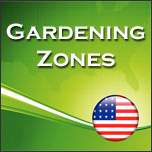How to Understand Gardening Zones

Do you want to plant flowers, shrubs and trees, but don’t know what zone you are?
Are you wondering what a “zone” is?
Then this article is for you. Today, we are taking a deeper look into gardening zones. We are going to answer what a zone is, why it is important to gardeners and what zone you live in. Whether you have a green thumb or you are new to the gardening world, knowing about zones is going to make gardening easier.
What is a zone?
It is not so much what is as what are. When a gardening book or blog refers to a zone they are referring to the USDA Plant Hardiness Zone Map. It is the standard that gardeners and anyone interested in growing use to decide what type of plants or trees are likely to grow in a location.
The map is broken up into 10 degree F zones by the “average annual minimum winter temperature”. The USDA plant hardiness map has divided North America up into 13 hardiness zones. The zones range from Zone 1 as the coldest -60 degrees to -55 degrees. Zone 13 is the warmest at 65 degrees to 70 degrees. Zone 13 is found only in Puerto Rico.
Why the Hardiness Zone Map is Important to Gardeners
Have you ever taken the time to plant a beautiful flower to watch it die after a hard winter? The idea behind the zones is just that, to insure that you know what to plant for your region. Every plant has its own ability to withstand certain temperatures.
What Zone Do You Live In?
The map is now available on the USDA Website.
“For the first time, the map is available as an interactive GIS-based map, for which a broadband Internet connection is recommended, and as static images for those with slower Internet access. Users may also simply type in a ZIP Code and find the hardiness zone for that area.”
The next time you read a gardening book that says that a flower is best planted in Zone 5 and you live in Zone 7, you may want to reconsider planting it. There are plenty of region directed planting guides. One way to enhance your plants and flowers ability to thrive in all seasons is by installing Rootsticks. Rootsticks provide your plants with the oxygen, nutrients and water they need to flourish.



